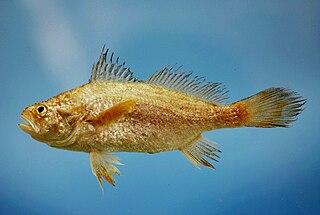
The flagtails are a family (Kuhliidae) of perciform fish of the Indo-Pacific area. The family consists of several species in one genus, Kuhlia. Most are euryhaline and often found in brackish water, but the genus also includes species restricted to marine or fresh water.

Combtooth blennies are blenniiformids; percomorph marine fish of the family Blenniidae, part of the order Blenniiformes. They are the largest family of blennies with around 401 known species in 58 genera. Combtooth blennies are found in tropical and subtropical waters in the Atlantic, Pacific and Indian Oceans; some species are also found in brackish and even freshwater environments.

Citharichthys is a genus of flatfish in the large-tooth flounder family, Paralichthyidae. They have both eyes on the left sides of their heads. They are native to the oceans around the Americas, with a single species, C. stampflii off the West African coast. Most are found in relatively shallow depths, but the genus also includes species found in deep water and species that enter fresh water.

Enneanectes is a genus of triplefin fish in the family Tripterygiidae.

Malacoctenus is a genus of labrisomid blennies native to the eastern Pacific Ocean and the Atlantic Ocean.

Anisotremus is a genus of grunts native to the eastern Pacific and western Atlantic Oceans. The name of this genus is compound of anisto meaning “different” and tremus meaning “hole”, referring to the different sized paired pores on each side of the head.

Entomacrodus is a genus of combtooth blennies.

Chasmodes is a small genus of combtooth blennies found in the western Atlantic Ocean.

Hypsoblennius gilberti, commonly known as the rockpool blenny, is a species of combtooth blenny found in the eastern Pacific Ocean. This species grows to a length of 17 centimetres (6.7 in) TL. The specific name honours the American ichthyologist Charles H. Gilbert (1859–1928).

Omobranchus is a large genus of combtooth blennies found in the Pacific, Atlantic, and Indian oceans.
Emblemaria is a genus of chaenopsid blennies found throughout the Pacific and Atlantic oceans.

Paraclinus is a genus of labrisomid blennies native to eastern Pacific Ocean and the western Atlantic Ocean.

Starksia is a genus of labrisomid blennies native to the western Atlantic Ocean and the eastern Pacific Ocean. Their typical length is 2 cm (0.79 in) SL. The generic name honours the American ichthyologist Edwin Chapin Starks (1867-1932) of Stanford University for his work on Pacific coastal fishes. As a genus Starksia is distinguished from other labrisomids by their scaled bodies, two obvious soft rays in the pelvic fin and the male's have an intromittent organ which is near to or attached to the first spine of their anal fins, which is also somewhat separated from the fin.

Anchoa is a genus of ray-finned fishes in the family Engraulidae. It currently consists of 35 species.

Notarius is a genus of fish in the family Ariidae found in the Atlantic and Pacific Ocean.

Tylosurus is a genus of needlefish, one of ten in the family Belonidae. They are found worldwide in tropical and warmer temperate seas and two species have been recorded as Lessepsian migrants in the eastern Mediterranean Sea.

Paralichthys is a genus of large-tooth flounders. Most species are native to the coastal waters of the Americas, but P. olivaceus is from northeast Asia. The largest species reaches about 1.5 m (5 ft) in length.

Stellifer is a genus of fish in the family Sciaenidae, the drums and croakers. It is found in New World waters. Many species are known commonly as stardrums.

Evermannia is a genus of gobies native to the eastern central Pacific Ocean coast of the Americas from Baja California to Panama. The genus name honours the American ichthyologist Barton Warren Evermann (1853–1932).

Microgobius is a genus of gobies native to the Pacific and Atlantic coasts of the Americas.



















